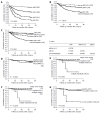Prognostic implication of isolated tumor cells and micrometastases in regional lymph nodes of gastric cancer
- PMID: 16273600
- PMCID: PMC4436711
- DOI: 10.3748/wjg.v11.i38.5920
Prognostic implication of isolated tumor cells and micrometastases in regional lymph nodes of gastric cancer
Abstract
Aim: To determine the prognostic significance of isolated tumor cells (ITCs) and lymph node micrometastases in gastric cancer.
Methods: Hematoxylin and eosin-stained slides of lymph node dissections of 632 consecutive gastric cancers were reviewed. Cytokeratin immunostaining was performed in 280 node-negative cases and 5 cases indefinite for lymph node metastases. Lymph node metastases were divided into ITCs, micrometastases, or macrometastases, according to the sizes of tumor deposits in largest dimension. ITCs were further classified into four groups according to metastasis pattern.
Results: Lymph node metastases were identified by immunostaining in 58 of 280 node-negative cases (20.7%) and were not significantly associated with patient survival (P = 0.3460). After cytokeratin immunostaining, 196 cases were classified as pN1, which consisted of 20 cases with micrometastases detected by immunostaining (pN1mi(i+)), 34 cases with only micrometastases (pN1mi), and 142 cases with pN1 with one or more macrometastases (pN1). Cases with pN1mi and pN1mi(i+) had a significantly better prognosis than the cases with pN1 (P = 0.0037). ITCs were found in 38 of these 58 cases, and could be divided into four groups: 12 cases with only a single cell pattern, 7 cases with multiple individual cells, 5 cases with single small cluster, and 14 cases with multiple small clusters. Among these four groups, cases with ITCs of multiple individual cell pattern showed the worst survival (median survival: 28 mo, P<0.0001).
Conclusion: Both size and pattern of lymph node metastases can give prognostic information on the survival of gastric cancer patients.
Figures


Similar articles
-
Isolated tumor cells in regional lymph nodes in patients with adenocarcinoma of the esophagogastric junction might represent part of true metastases.Hum Pathol. 2019 Nov;93:90-96. doi: 10.1016/j.humpath.2019.08.015. Epub 2019 Aug 22. Hum Pathol. 2019. PMID: 31445841
-
Biological significance of occult micrometastases in histologically negative axillary lymph nodes in breast cancer patients using the recent American Joint Committee on Cancer breast cancer staging system.Breast J. 2006 Jul-Aug;12(4):294-301. doi: 10.1111/j.1075-122X.2006.00267.x. Breast J. 2006. PMID: 16848838
-
Immunohistochemically detected micrometastases of the lymph nodes in patients with gastric carcinoma.Cancer. 2001 Aug 15;92(4):753-60. doi: 10.1002/1097-0142(20010815)92:4<753::aid-cncr1379>3.0.co;2-5. Cancer. 2001. PMID: 11550144
-
Staging of women with breast cancer after introduction of sentinel node guided axillary dissection.Dan Med J. 2012 Jul;59(7):B4475. Dan Med J. 2012. PMID: 22759850 Review.
-
Detection of micrometastases in sentinel node navigation surgery for gastric cancer.Surg Oncol. 2008 Sep;17(3):203-10. doi: 10.1016/j.suronc.2008.04.008. Epub 2008 Jun 6. Surg Oncol. 2008. PMID: 18539025 Review.
Cited by
-
Lymph node, peritoneal and bone marrow micrometastases in gastric cancer: Their clinical significance.World J Gastrointest Oncol. 2012 Feb 15;4(2):16-21. doi: 10.4251/wjgo.v4.i2.16. World J Gastrointest Oncol. 2012. PMID: 22403737 Free PMC article.
-
Routine modified D2 lymphadenectomy performance in pT1-T2N0 gastric cancer.World J Gastroenterol. 2009 Nov 28;15(44):5568-72. doi: 10.3748/wjg.15.5568. World J Gastroenterol. 2009. PMID: 19938196 Free PMC article.
-
Gastric carcinoma: stage migration by immunohistochemically detected lymph node micrometastases.Gastric Cancer. 2015 Jan;18(1):100-8. doi: 10.1007/s10120-014-0352-4. Epub 2014 Feb 19. Gastric Cancer. 2015. PMID: 24550066
-
Lymph Node Micrometastases are Associated with Worse Survival in Patients with Otherwise Node-Negative Hilar Cholangiocarcinoma.Ann Surg Oncol. 2015 Dec;22 Suppl 3:S1107-15. doi: 10.1245/s10434-015-4723-9. Epub 2015 Jul 16. Ann Surg Oncol. 2015. PMID: 26178761 Free PMC article.
-
Sentinel lymph node biopsy in the management of early-stage cervical carcinoma.Gynecol Oncol. 2011 Mar;120(3):347-52. doi: 10.1016/j.ygyno.2010.12.334. Epub 2011 Jan 8. Gynecol Oncol. 2011. PMID: 21216450 Free PMC article.
References
-
- Adachi Y, Kamakura T, Mori M, Baba H, Maehara Y, Sugimachi K. Prognostic significance of the number of positive lymph nodes in gastric carcinoma. Br J Surg. 1994;81:414–416. - PubMed
-
- Isozaki H, Okajima K, Fujii K. Histological evaluation of lymph node metastasis on serial sectioning in gastric cancer with radical lymphadenectomy. Hepatogastroenterology. 1997;44:1133–1136. - PubMed
-
- Prognostic importance of occult axillary lymph node micrometastases from breast cancers. International (Ludwig) Breast Cancer Study Group. Lancet. 1990;335:1565–1568. - PubMed
-
- Cote RJ, Peterson HF, Chaiwun B, Gelber RD, Goldhirsch A, Castiglione-Gertsch M, Gusterson B, Neville AM. Role of immunohistochemical detection of lymph-node metastases in management of breast cancer. International Breast Cancer Study Group. Lancet. 1999;354:896–900. - PubMed
-
- Dowlatshahi K, Fan M, Snider HC, Habib FA. Lymph node micrometastases from breast carcinoma: reviewing the dilemma. Cancer. 1997;80:1188–1197. - PubMed
Publication types
MeSH terms
Substances
LinkOut - more resources
Full Text Sources
Medical
Miscellaneous

